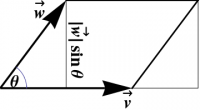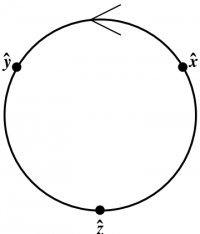The Cross Product
 The cross product is fundamentally a directed area. The magnitude of the cross product is defined to be the area of the parallelogram whose sides are the two vectors in the cross product.
The cross product is fundamentally a directed area. The magnitude of the cross product is defined to be the area of the parallelogram whose sides are the two vectors in the cross product.
In the figure above, if the horizontal vector is $\vv$ and the upward-pointing vector is $\ww$, then the height of the parallelogram is $|\ww|\sin\theta$, so its area is \begin{equation} |\vv\times\ww| = |\vv||\ww|\sin\theta \label{crossmagnitude} \end{equation} which is therefore the magnitude of the cross product.
An immediate consequence of Equation ($\ref{crossmagnitude}$) is that, if two vectors are parallel, their cross product is zero, \begin{equation} \vv\parallel\ww \Longleftrightarrow \vv\times\ww=\zero \end{equation} The direction of the cross product is given by the right-hand rule: Point the fingers of your right hand along the first vector ($\vv$), and curl your fingers toward the second vector ($\ww$). You may have to flip your hand over to make this work. Now stick out your thumb; that is the direction of $\vv\times\ww$. In the example shown above, $\vv\times\ww$ points out of the page. The right-hand rule implies that \begin{equation} \ww\times\vv = -\vv\times\ww \end{equation} as you should verify for yourself by suitably positioning your hand. Thus, the cross product is not commutative. 1) Another important property of the cross product is that the cross product of a vector with itself is zero, \begin{equation} \vv\times\vv = \zero \end{equation} which follows from any of the preceding three equations.
In terms of the standard orthonormal basis, the geometric formula quickly yields \begin{eqnarray} \xhat\times\yhat &=& \zhat \\ \yhat\times\zhat &=& \xhat \\ \zhat\times\xhat &=& \yhat \end{eqnarray} This cyclic nature of the cross product can be emphasized by abbreviating this multiplication table as shown in the figure below. 2)  Products in the direction of the arrow get a plus sign; products against the arrow get a minus sign.
Products in the direction of the arrow get a plus sign; products against the arrow get a minus sign.
Using an orthonormal basis such as $\{\xhat,\yhat,\zhat\}$, the geometric formula reduces to the standard component form of the cross product. 3) If $\vv=v_x\,\xhat+v_y\,\yhat+v_z\,\zhat$ and $\ww=w_x\,\xhat+w_y\,\yhat+w_z\,\zhat$, then \begin{eqnarray} \vv\times\ww &=& (v_x\,\xhat+v_y\,\yhat+v_z\,\zhat) \times (w_x\,\xhat+w_y\,\yhat+w_z\,\zhat) \cr &=& (v_y w_z - v_z w_y)\,\xhat + (v_z w_x - v_x w_z) \,\yhat + (v_x w_y - v_y w_x)\,\zhat \label{CrossAlg} \end{eqnarray} which is often written as the symbolic determinant \begin{equation} \vv\times\ww = \left| \matrix{\xhat& \yhat& \zhat\cr \noalign{\smallskip} v_x& v_y& v_z\cr w_x& w_y& w_z\cr} \right| \label{CrossDet} \end{equation}
We encourage you to use ($\ref{CrossDet}$), rather than simply memorizing ($\ref{CrossAlg}$). We also encourage you to compute the determinant as described below, rather than using minors; this tends to minimize sign errors. A $3\times3$ determinant can be computed in the form

where one multiplies the terms along each diagonal line, subtracting the products obtained along lines going down to the left from those along lines going down to the right. While this method works only for ($2\times2$ and) $3\times3$ determinants, it emphasizes the cyclic nature of the cross product.
Another important skill is knowing when not to use a determinant at all. For simple cross products, such as $(\xhat+3\,\yhat)\times\zhat$, it is easier to use the multiplication table directly.
It is also worth pointing out that the multiplication table and the determinant method generalize naturally to any (right-handed) orthonormal basis; all that is needed is to replace the rectangular basis $\{\xhat,\yhat,\zhat\}$ by the one being used (in the right order!). For example, in cylindrical coordinates, not only is \begin{equation} \rhat\times\phat = \zhat \end{equation} (and cyclic permutations), but cross products can be computed as \begin{equation} \vv\times\ww = \left| \matrix{\rhat& \phat& \zhat\cr v_r& v_\phi& v_z\cr w_r& w_\phi& w_z\cr} \right| \end{equation} where of course $\vv=v_r\,\rhat+v_\phi\,\phat+v_z\,\zhat$ and similarly for $\ww$.
A good problem emphasizing the geometry of the cross product is to find the area of the triangle formed by connecting the tips of the vectors $\xhat$, $\yhat$, $\zhat$ (whose base is at the origin).